
Chytolita is a monotypic litter moth genus of the family Erebidae erected by Augustus Radcliffe Grote in 1873. Its only species, Chytolita morbidalis, the morbid owlet moth or morbid owlet, was first described by Achille Guenée in 1854. It is found in large parts of North America, from coast to coast in the north and south to North Carolina, Texas and Florida in the west. The habitat consists of deciduous woods and edges.

Phalaenostola is a genus of litter moths of the family Erebidae. The genus was erected by Augustus Radcliffe Grote in 1873.
Abagrotis orbis, the well-marked cutworm or Barnes' climbing cutworm, is a moth of the family Noctuidae. The species was first described by Augustus Radcliffe Grote in 1876. It is in southwestern North America, extending eastward across the plains and with a large disjunct population in dune habitats in the southern Great Lakes area. It extends into western Canada only in the southern interior of British Columbia and southern Alberta and Saskatchewan.

Brachionycha borealis is a moth of the family Noctuidae first described by Smith in 1899. It is found in North America from Maine and Pennsylvania west to central Alberta.
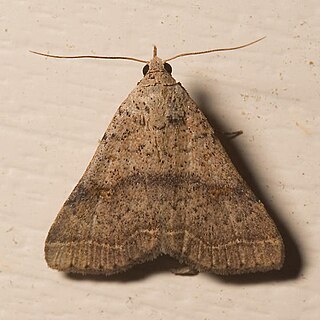
Bleptina caradrinalis, the bent-winged owlet or variable snout moth, is a species of moth of the family Erebidae. It was described by Achille Guenée in 1852. It is found in North America, from Nova Scotia west to British Columbia, south to Arizona. Furthermore, it is found from southern North America south to Brazil and on the Antilles.
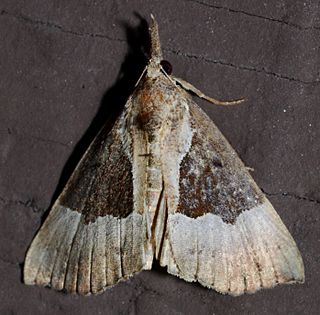
Hypena bijugalis, the dimorphic bomolocha, dimorphic hypena or toothed snout-moth, is a moth of the family Erebidae. The species was first described by Francis Walker in 1859. It is found in North America from Nova Scotia across southern Canada to Vancouver Island, south over the whole United States to Florida.
Hypena edictalis, the large bomolocha, is a moth of the family Erebidae. The species was first described by Francis Walker in 1859. It is found in North America from Quebec and Maine south to Virginia and Kentucky, west to the foothills of Alberta and the Peace River area of British Columbia.
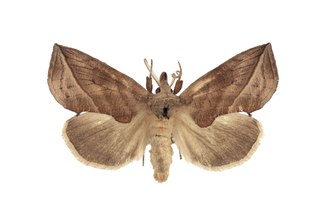
Calyptra canadensis, the Canadian owlet or meadow rue owlet moth, is a moth of the family Erebidae. The species was first described by Charles J. S. Bethune in 1865. It is found in North America from Nova Scotia to North Carolina in mountains, west to Texas, north to Saskatchewan, and occasionally Alberta. It is the only insect from the Calyptra genus to habitat North America.
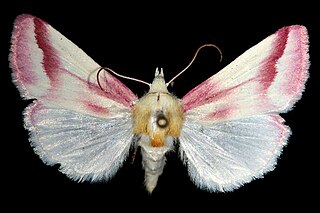
Schinia gaurae, the clouded crimson, is a moth of the family Noctuidae. The species was first described by James Edward Smith in 1797. It is found in North America from Illinois west across southern Saskatchewan and Alberta, south to Florida, Texas, Arizona and south into Mexico.
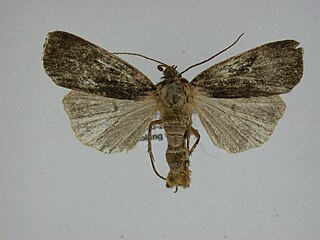
Pseudohermonassa bicarnea, the pink-spotted dart, is a moth of the family Noctuidae. The species was first described by Achille Guenée in 1852. It is found in eastern North America, and as far west as south-central Saskatchewan and central North Dakota, south to western North Carolina. It has recently been recorded from Tennessee.
Xestia normaniana, or Norman's dart, is a moth of the family Noctuidae. The species was first described by Augustus Radcliffe Grote in 1874. It is found in North America from Nova Scotia across southern and central Canada to Alberta. In the eastern United States it ranges from Maine to eastern Minnesota, and south along the Appalachians to western North Carolina. It has recently been recorded from Tennessee.
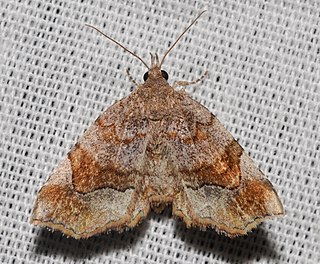
Pangrapta decoralis, the decorated owlet, is a moth in the family Erebidae. The species was first described by Jacob Hübner in 1818. It is found in North America from Alberta to Nova Scotia south to Florida and Texas.

Phalaenophana pyramusalis, the dark-banded owlet, is a moth of the family Erebidae. The species was first described by Francis Walker in 1859. It is found in North America from Saskatchewan to Nova Scotia, south to North Carolina and Texas.
Macrochilo bivittata, the two-striped snout-moth, is a litter moth of the family Erebidae. The species was first described by Augustus Radcliffe Grote in 1877. It is found from the Atlantic coast west across the parklands and southern boreal forest of North America to central Alberta, south to Massachusetts and Ohio.

Phalaenostola eumelusalis, the punctuated owlet or dark phalaenostola, is a moth of the family Erebidae. The species was first described by Francis Walker in 1859. It is found in North America from New Brunswick, North Dakota and South Dakota to Maine, south to Georgia and Iowa. In the north it is also found in Saskatchewan.

Phalaenostola larentioides, the black-banded owlet, is a moth of the family Erebidae. The species was first described by Augustus Radcliffe Grote in 1873. It is found in North America from New Brunswick and Wisconsin to Maine, south to Florida and Texas, west to Ontario.
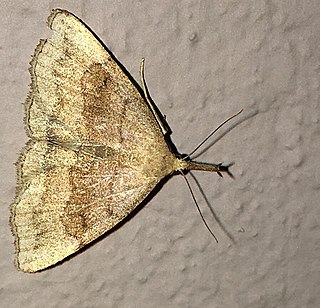
Phalaenostola metonalis, the pale phalaenostola, tufted snout or pale epidelta, is a moth of the family Erebidae. The species was first described by Francis Walker in 1859. It is found in North America from British Columbia to Newfoundland, south to North Carolina, west to Missouri.
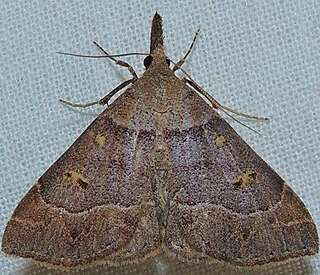
Renia flavipunctalis, the yellow-dotted renia, yellow-spotted renia or even-lined renia, is a litter moth of the family Erebidae. The species was first described by Carl Geyer in 1832. It is found from southern Canada to Florida and Texas.

Palthis angulalis, the dark-spotted palthis, is a moth of the family Erebidae. The species was first described by Jacob Hübner in 1796. It is found from Newfoundland west to coastal British Columbia, south to Florida and Texas.
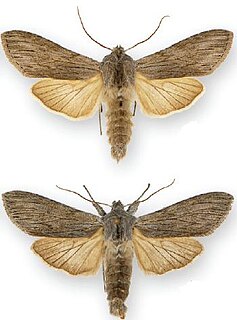
Cucullia intermedia, the dusky hooded owlet, intermediate cucullia, goldenrod cutworm or intermediate hooded owlet, is a moth of the family Noctuidae. The species was first described by Adolph Speyer in 1870. It is found from coast to coast across southern Canada and the northern United States, south in the west to California and to Pennsylvania in the east. In the Rocky Mountains it is found south to the White Mountains in east-central Arizona and occurs commonly in Utah, Colorado and north-eastern Nevada.













